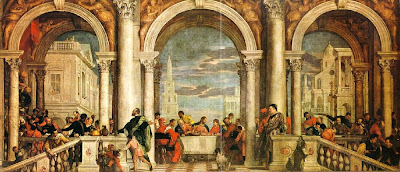Wandering through the halls of the Academia
in Venice I have to admit, I was thrown by the differences between the Venetian
painting of the 15th and 16th centuries and the
Florentine Renaissance that I had imbibed over the past ten days. Everything in
the Academia felt very foreign until I walked into a room in which one whole
wall was taken over by Veronese’s Christ
in the House of Levi, 1573. I immediately felt as though I had come home. I
knew the painting, at least, it was familiar to me in a way that the Venetian
paintings are not. Because it is the sibling of The Wedding Feast at Cana, painted 10 years earlier that now sits
opposite the Mona Lisa in the Louvre.
Veronese does dinner time like no other
Renaissance-Mannerist painter. And dinner always looks like so much fun in
Veronese’s paintings. Veronese painted Christ
in the House of Levi for the Dominican order of Santi Giovani e Paolo’s
refectory wall in their Venice convent. This painting is a massive 18’ x 42’
indicating that dinner was an important moment in the day, and a great
opportunity to be reminded of the grandeur of Venetian life. Veronese rises to
the occasion and paints a majestic scene that doesn't care much for the religious
subject matter. The painting is, afterall, supposed to be a representation of
the Last Supper.
There is so much going on in the painting
that I found myself wandering around, searching to find a place to begin
looking, deciding which scene I would focus on. I recognize the two figures on
the terrace of the building behind where dinner is being served, looking over
the terrace, fascinated by the events going on below. On the left hand side of
the painting the figures are from the orient, and I am reminded that men in
sumptuous silks and decorated turbans must have been a familiar sight in sixteenth century Venice. Unlike the frescoes I had spent time with in more southern regions of
Italy, there are also black men involved in Veronese's feast, but even though they
richly dressed, still, their backs are turned. Similarly there are midgets,
drunks, merchants and dogs invited for dinner, guests who apparently created
quite a stir at the time. In fact, because of them Veronese was put before an
Inquisition. Even in Venice it is not okay for such low life to be eating at Christ’s
dinner table.
Of course, the most glorious aspect of the
painting is the brilliantly coloured clothes of the dinner guests. In greens and
reds and yellows, Christ’s pink robe and blue cloak, all of them must have been
resplendent on the refectory wall. And to reinforce that no one pays much
attention to Christ (surely another point of order for the Inquisition) the
looks of the dinner guests meet only as their lines of sight cross in front of the painting, somewhere above the
tables at which the Dominicans sat to eat their meals. Only the man on Christ’s
left actually looks at him while everyone else’s attention is drawn away by a
deal, a promise, or a protestation from a fellow guest.
This is a raucous and energy filled
occasion, but while we hear a lot of noise, we sense a lot of tension. No one
is smiling or laughing, but rather, they are all busy, filled with the passions of doing business. This turbulence is somehow reflected in the brilliant
and multi colours of the figures’ magnificent robes. To be sure, there’s very
little cohesion to Christ in the House of
Levi – not even Christ himself at his last supper seems able to or even
interested in bringing unity to this banquet.





No comments:
Post a Comment